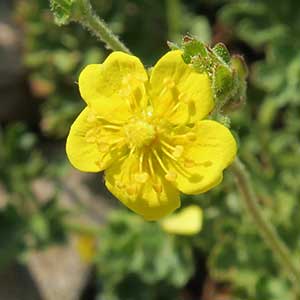Potentilla brevifolia
Potentilla ambigens
short-leaf cinquefoil, sparse-leaf cinquefoil
silkyleaf cinquefoil, silkyleaf or giant or southern Rocky Mountain cinquefoil
(2–)3–7(–8) dm, lengths (1–)1.5–2.5 times basal leaves.
petiole 1–4 cm, eglandular hairs absent or sparse, spreading, less than 1 mm, weak, glands abundant.
pinnate, 15–45(–50) cm;
petiole (5–)8–20 cm, long hairs abundant to dense, ascending to appressed, (1–)2–3 mm, ± stiff, rarely weak, short or crisped hairs absent or sparse, cottony hairs absent, glands sparse, often obscured;
leaflets not conduplicate, lateral ones evenly paired, (3–)4–7 per side on distal ± 1/2 of leaf axis, most pairs ± decurrent, rachis winged, distal sometimes confluent with terminal leaflet, larger leaflets narrowly obovate, (2–)3–7 × 1–2.5 cm, distal 3/4+ of margin incised 1/3 to midvein, teeth 6–18 per side, 1–4 mm, surfaces ± similar, abaxial grayish, long hairs sparse to common (mostly on veins), 0.5–2 mm, ± stiff, rarely weak, short-crisped hairs absent or sparse to common, cottony hairs absent, glands sparse to common, adaxial green to grayish, long and short hairs not differentiated, sparse to common, crisped and cottony hairs absent, glands absent or sparse.
(0–)1–3.
(10–)20–60-flowered.
(0.5–)1–3(–6) cm.
epicalyx bractlets lanceolate-elliptic to ovate, 2–4 × 0.8–2 mm;
sepals 3–5(–7) mm, apex broadly acute to obtuse;
petals 3.5–6.5 × 3–5 mm;
filaments 1–2.5 mm, anthers 0.5–0.6 mm;
carpels 10–15.
epicalyx bractlets lanceolate to narrowly ovate or elliptic, 3–6 × 1–1.5 mm, 2/3 as long as to nearly equal to sepals, abaxial vestiture ± similar to sepals, not glabrescent, straight hairs sparse to common, crisped or cottony hairs usually absent;
hypanthium 3–6 mm diam.;
sepals 4–7 mm, apex acute to acuminate;
petals (6–)7–10 × 5–9 mm;
filaments (1–)1.5–4 mm, anthers 0.7–0.9(–1) mm;
carpels 20–30, styles (1–)1.8–3 mm.
1–1.5 mm.
1.4–1.6 mm, smooth.
= 82.
Potentilla brevifolia
Potentilla ambigens
Potentilla brevifolia is found mainly in alpine situations in the Pioneer, Sawtooth, Smoky, and White Cloud mountains of central Idaho; the Madison Range of western Montana; the Jarbidge Range of northeastern Nevada; the Blue, Steens, and Wallowa mountains of eastern Oregon; and the Teton Range of northwestern Wyoming. The elongate caudices are easily covered by moving soil and talus.
(Discussion copyrighted by Flora of North America; reprinted with permission.)
Of conservation concern.
Potentilla ambigens is one of the more distinctive species in sect. Leucophyllae, comprising exceptionally large plants with large, coarsely hairy leaves. Although sometimes confused with P. hippiana, P. ambigens lacks the crisped-cottony vestiture of that species and is usually morphologically distinctive even where both species occur together (D. G. Anderson, www.fs.fed.us/r2/projects/scp/assessments/potentillaambigens.pdf).
Potentilla ambigens occurs in Wyoming (at least historically), along the eastern slope of the Rocky Mountains to northern Colorado, and in scattered locations in the high mountains of New Mexico as far south as the Sacramento Mountains, Otero County. The species is of conservation concern in Colorado and has not been documented in Wyoming since 1900 (D. G. Anderson, www.fs.fed.us/r2/projects/scp/assessments/potentillaambigens.pdf).
(Discussion copyrighted by Flora of North America; reprinted with permission.)


